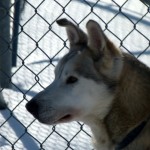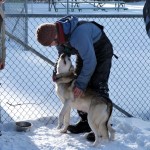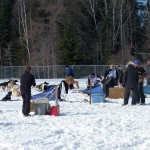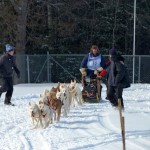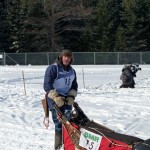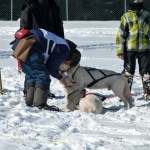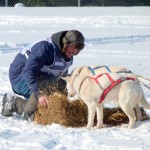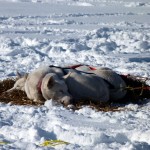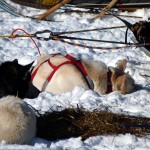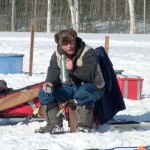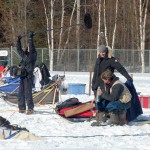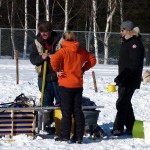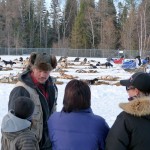In the last bulletin I warned you that I would make it to breakfast at the motel restaurant, blizzard or no blizzard, for one of their western omelets. There’s nothing like having a goal first thing in the morning, especially if it relates to food. Is there any meal better than breakfast? I think not. And it’s even better if you’ve got good company
So, five of us, the Head Musher, our mushing friend Ruth, Gino who ran the 100-miler and came in sixth, Peter Franke who ran the two 13 milers with a purebred Siberian team and came in first and yours truly who did absolutely nothing but drive a car around and schmooze with anyone who was not frozen solid, commandeered a corner table about 7:30 this morning in the motel restaurant. Several western omelets bit the dust. I can account for one of them.
One of the best parts of these trips is listening to people who mush talk about mushing. You hear about the latest sled technology, who makes the warmest boots, how many layers of clothing you should wear, which brand of mittens is best and, of course, you hear about dogs. There is no end to the talk about which breeders and which genetic lines are winning races. People who engage in sporting activities share a common trait – they love to talk about what they do and how they do it. It makes no difference whether it’s golfers talking about the latest souped-up driver or a musher talking about the latest souped-up sled. Anyway, that’s how we spent a lengthy breakfast.
I promised that I would tell you about our time spent at the 50-mile check-point for the 100 mile race on Sunday and I’ll start off by telling you about a dog that got dropped by one of the teams. His name is Neptune, a beautiful Siberian, who by the time we got to the check point had been brought to the area by a race volunteer. His musher noticed that he was not pulling and feared that he had injured himself. So Neptune was sidelined, “dropped” they call it, waiting for handlers to pick him up. Here is Neptune when I first saw him:
A pretty dog, but not a happy camper. He didn’t appear to be injured, except maybe his pride. He didn’t appreciate being separated from his team and his musher.
Shortly thereafter, his musher pulled into the checkpoint and came over to see him and I lucked out and got one of those pictures that come along every once in a while. The minute he saw the musher his tail started wagging, in fact, his entire rear-end was wagging. You could just see the joy in his face. And then he looked up at the musher and I snapped the following picture. You get the full size image on this one.
His front paws danced and he looked right into his mushers eyes. This picture says all there is to say about the relationship between dog and musher.
The checkpoint is at a place called Lac Frontiere, right on the Canada/U.S. border. As the car drives it’s about 35 miles from St Pamphile. As the dog-sled mushes, it’s about 50 miles away. It’s one of those places that, when you are driving to it, you never think you’re going to get there and then, when you arrive, you’re not sure you’re there.
The mushers start at St. Pamphile every two minutes. They arrive at Lac Frontiere anywhere between four and six hours later. The check point is behind a Catholic Church and next to a hockey rink. By the way, every Quebec village has a Catholic Church and a hockey rink, symbols of the two major religions in Quebec.
Casual fans of mushing show up for the start of races. It is exciting to see the teams charge down the starting chute with everybody cheering. The serious mushing fans show up at the checkpoints. That’s where you get a real glimpse of what the sport is about.
So, here’s the scene when we arrive. Each team has a slot in which to park and the teams are parallel to each other. At this point, three or four teams have checked in and the mushers are tending to their dogs. Canadian Broadcasting covered the event. You can see the guy on the right holding the boom microphone as one of the mushers is interviewed.
About fifteen minutes after we arrived, Gino pulled in. A musher, a sled, a couple of hundred pounds of cargo, and twelve dogs. To quote Gino: “If you are going to run twelve dogs, you had better be able to control them, or you’re going to go somewhere you don’t want to go!” That’s six or seven hundred pounds of dogs genetically disposed to pull.
After the dogs and sled are secured, the following five things happen over the next 45 minutes or so. First, you’ll see every musher walk down the gangline and praise every one of his dogs individually. Here’s Gino with his lead dogs, J.R. and Niki, they both did a super job and it was Niki’s first time in lead.
That’s Niki looking up at Gino
The second thing that happens is the dogs are watered and fed snacks. Some of the mushers give their dogs cooked beaver meat. It’s rumored to be the worst smelling stuff ever. I’m taking their word for it. None of them have any trouble eating or drinking after a 50-mile run.
Next, straw is laid out so that the dogs can rest.
The straw provides some insulation for the dogs but I’m not convinced that the dogs need it. They do seem to take right to the straw though…
Some seem to prefer to remain vigilant and keep an eye on the musher…
While others just snooze on the snow, right next to the straw…
When the dogs are cared for, the musher has a chance to rest and eat…
Until somebody wants an interview
Or a fellow musher needs help fixing a runner…
Or a little kid wants to talk to a real musher…
There are strict rules against providing help to a musher. The race marshals provide the teams with water and straw for the dogs and there is a place for the mushers to relax and eat but the musher will be disqualified if he accepts help from any outside agency.
After a four hour mandatory rest, the mushers were back on their sleds. Gino finished in a little over eight hours total time, averaging a just over 5 miles per hour over the 100 miles. The winner ran each mile about 20 seconds faster than Gino, not a very big margin for any single mile, but it adds up over a long race.
Our day, which began with a trip to the emergency room, and migrated through lac Frontiere, ended with a flat tire in the parking lot of a pizza restaurant in St. Pamphile. We were rescued by a local Good Samaritan. That’s a story for another day.
We’re back in St. Jacques with some serious training scheduled for today…and it’s snowing.
Later,
The One-Man Pit Crew

